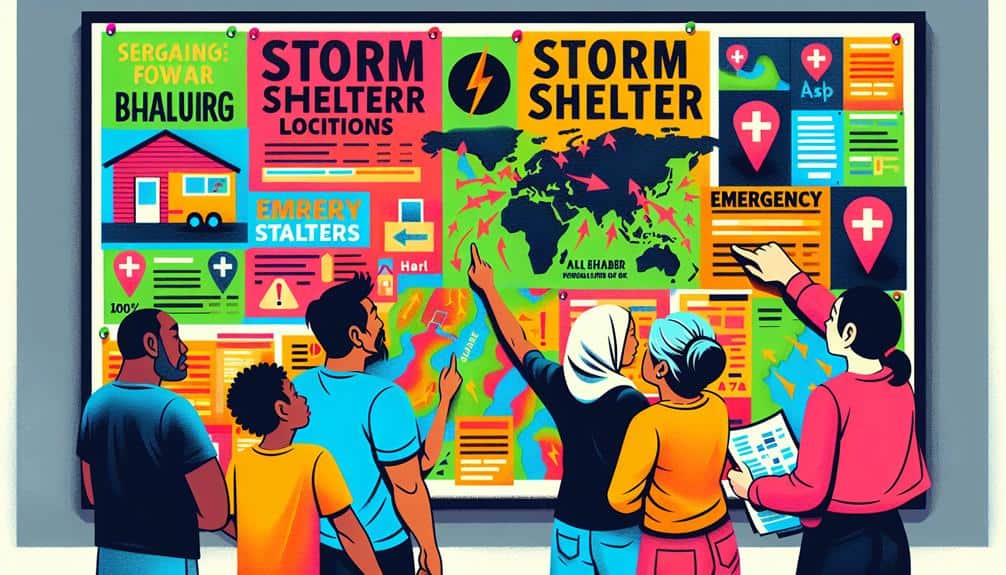We can quickly locate storm shelters by using weather apps on our smartphones, which provide real-time updates and critical safety tips. Checking local maps available online or at community centers is another reliable method. Contacting local authorities like emergency management agencies or using non-emergency hotlines also gives us up-to-date information. Social media alerts from local emergency groups guarantee we don't miss any notifications. Finally, community bulletin boards and neighborhood watch groups are valuable for real-time, local shelter information. Using these methods, we're equipped to find storm shelters swiftly and stay safe. To explore each method further, stick around.
Key Points
- Use weather apps on smartphones for real-time updates and nearby storm shelter locations.
- Check local government websites for extensive lists and real-time updates of storm shelters.
- Follow local emergency management agencies on social media for reliable and immediate shelter information.
- Consult community centers or libraries for printed maps marking local storm shelters.
Use Weather Apps
In today's digital age, we can quickly find nearby storm shelters by using weather apps on our smartphones. These apps offer more than just weather forecasts—they're essential tools for staying safe during severe weather events. By enabling emergency notifications, we receive immediate alerts about hazardous conditions and recommendations on actions to take.
Weather apps provide real-time updates that are pivotal when every minute counts. They show us shelter locations relative to our current position, allowing us to make informed decisions swiftly. This feature is a game-changer, especially when we're on the move or in unfamiliar areas.
Additionally, these apps often include critical safety tips tailored to the specific type of storm we're facing, whether it's a tornado, hurricane, or severe thunderstorm. With this information at our fingertips, we can better prepare and respond to emergencies, ensuring not just our safety but also the safety of those around us.
Check Local Maps
While weather apps are invaluable, we should also check local maps for storm shelter locations. Local maps offer a broader perspective and can reveal shelters that mightn't appear on smaller-scale apps.
Here's how we can make the most out of local maps:
- Online directories: Websites dedicated to emergency preparedness often provide detailed maps. These directories are updated frequently and can be lifesavers.
- Community centers: Many community centers distribute printed local maps marking storm shelters. These maps are especially useful when digital access is compromised.
- Local government websites: Municipal websites usually have sections for emergency plans, including storm shelter locations. These resources are generally reliable and vetted for accuracy.
Utilizing these diverse sources guarantees we've multiple options for finding nearby shelters quickly. Let's not forget to incorporate these maps into our emergency plans.
Contact Local Authorities
Regularly, connecting with local authorities can provide us with the most up-to-date and precise information on storm shelter locations. Local government offices, emergency management agencies, and public safety departments are often the first to know and disseminate information during severe weather events.
First, we should call the emergency hotline in our area. These hotlines are designed to handle urgent inquiries and provide immediate assistance. By dialing these numbers, we can quickly learn about the nearest storm shelters and any specific instructions we need to follow.
Additionally, local police and fire departments are valuable resources. They work closely with emergency management teams and can direct us to the safest locations. We can either call their non-emergency numbers or visit their websites for updates and shelter maps.
Don't forget about city or county websites. These online platforms often have dedicated sections for public safety and emergency preparedness. Here, we can find extensive lists of storm shelters, along with real-time updates.
Social Media Alerts
We can quickly access real-time information on storm shelters by following local emergency management agencies on social media platforms. These agencies often post updates that can guide us to the nearest shelter during a storm. By leveraging the power of social media, we gain immediate access to critical information that can make all the difference in an emergency.
Social media alerts often use emergency hashtags to aggregate information rapidly. This makes it easier for us to find relevant posts by searching hashtags such as #StormShelter or #EmergencySafeZone. Additionally, joining local Facebook groups dedicated to community safety can provide us with real-time updates and crowd-sourced information on shelter availability.
Here are some effective ways to stay updated:
- Follow local emergency management agencies: Their official pages often provide the most reliable information.
- Search for emergency hashtags: Hashtags like #ShelterInPlace can quickly direct us to the latest updates.
- Join Facebook groups: These groups can offer timely information and tips from fellow community members.
Community Bulletin Boards

Local community bulletin boards serve as a valuable resource for finding storm shelters quickly. These boards, often located in community centers, libraries, and local businesses, provide up-to-date information about the nearest shelters. We can rely on these bulletin boards because they're maintained by community members who care about our safety.
Online forums are an extension of community bulletin boards, offering a digital space where we can share and find information rapidly. By visiting neighborhood-specific forums, we can access real-time updates and recommendations for storm shelters. It's a quick way to connect with people in our area who might've firsthand information.
Neighborhood watch groups also play an essential role in disseminating shelter information. These groups are often the first to know about local emergencies and can provide reliable guidance on where to find safety. By participating in or following our neighborhood watch, we stay informed and prepared.
In essence, community bulletin boards, both physical and online, along with neighborhood watch groups, form a thorough and effective network. They guarantee we've immediate access to the information we need to locate storm shelters swiftly and efficiently.
Frequently Asked Questions
Are There Online Directories Specifically for Storm Shelters?
Although some might doubt their reliability, we've found online databases dedicated to storm shelters incredibly efficient. These resources, coupled with community resources, guarantee we have quick access to crucial information when it matters most.
Can Schools and Churches Serve as Temporary Storm Shelters?
Yes, schools and churches can serve as temporary storm shelters. They're valuable community resources that often have safety protocols in place to guarantee everyone's protection during emergencies. Let's utilize these facilities to maximize our safety and freedom.
How Can I Find Storm Shelters for People With Disabilities?
We can find storm shelters for people with disabilities by checking local resources that highlight accessibility accommodations, and engaging in community outreach programs. Let's guarantee everyone has the freedom to access safe and secure shelter options.
Are There Any Mobile Apps Dedicated Solely to Locating Storm Shelters?
Let's cut to the chase: yes, there are mobile apps solely for locating storm shelters. These apps often boast user reviews, app features, safety ratings, and accessibility features, ensuring we find the safest, most accessible options quickly.
Can I Use Satellite Imagery to Identify Storm Shelters in My Area?
Yes, we can use satellite imagery to identify storm shelters, but it's not always dependable. Community outreach remains essential for accurate information. Let's combine both to make sure we locate the safest shelters efficiently.


